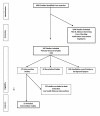Which providers can bridge the health literacy gap in lifestyle risk factor modification education: a systematic review and narrative synthesis
- PMID: 22639799
- PMCID: PMC3515410
- DOI: 10.1186/1471-2296-13-44
Which providers can bridge the health literacy gap in lifestyle risk factor modification education: a systematic review and narrative synthesis
Abstract
Background: People with low health literacy may not have the capacity to self-manage their health and prevent the development of chronic disease through lifestyle risk factor modification. The aim of this narrative synthesis is to determine the effectiveness of primary healthcare providers in developing health literacy of patients to make SNAPW (smoking, nutrition, alcohol, physical activity and weight) lifestyle changes.
Methods: Studies were identified by searching Medline, Embase, Cochrane Library, CINAHL, Joanna Briggs Institute, Psychinfo, Web of Science, Scopus, APAIS, Australian Medical Index, Community of Science and Google Scholar from 1 January 1985 to 30 April 2009. Health literacy and related concepts are poorly indexed in the databases so a list of text words were developed and tested for use. Hand searches were also conducted of four key journals. Studies published in English and included males and females aged 18 years and over with at least one SNAPW risk factor for the development of a chronic disease. The interventions had to be implemented within primary health care, with an aim to influence the health literacy of patients to make SNAPW lifestyle changes. The studies had to report an outcome measure associated with health literacy (knowledge, skills, attitudes, self efficacy, stages of change, motivation and patient activation) and SNAPW risk factor.The definition of health literacy in terms of functional, communicative and critical health literacy provided the guiding framework for the review.
Results: 52 papers were included that described interventions to address health literacy and lifestyle risk factor modification provided by different health professionals. Most of the studies (71%, 37/52) demonstrated an improvement in health literacy, in particular interventions of a moderate to high intensity.Non medical health care providers were effective in improving health literacy. However this was confounded by intensity of intervention. Provider barriers impacted on their relationship with patients.
Conclusion: Capacity to provide interventions of sufficient intensity is an important condition for effective health literacy support for lifestyle change. This has implications for workforce development and the organisation of primary health care.
References
-
- Commonwealth of Australia. Building a 21st Century Primary Health Care System Australia’s First National Primary Health Care Strategy. Commonwealth of Australia, Canberra; 2010.
-
- World Health Organization. Preventing Chronic Disease: a Vital Investment. WHO Press; 2007.
-
- Australian Institute of Health and Welfare. The Burden of Disease and Injury in Australia. 2000.
-
- Joint WHO/FAO Expert Consultation on Diet NatPo Diseases C. Diet, Nutrition and The Prevention of Chronic Diseases: Report of a Joint Who/Fao Expert Consultation. , Geneva, Switzerland; 2002.
-
- Nutbeam D, Kickbusch I. Advancing health literacy: a global challenge for the 21st century. Heal Promot Int. 2000;15(3):183–184. doi: 10.1093/heapro/15.3.183. - DOI
Publication types
MeSH terms
LinkOut - more resources
Full Text Sources
Medical
Miscellaneous


